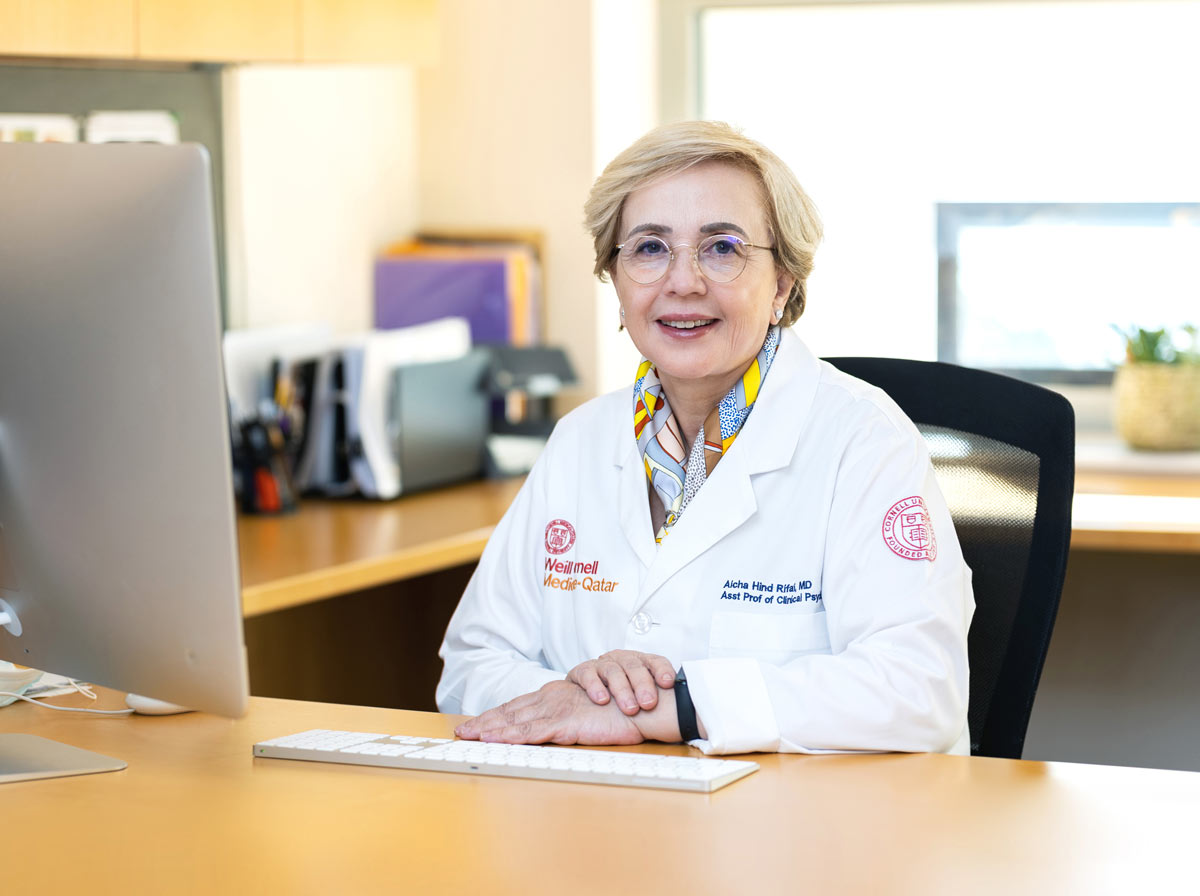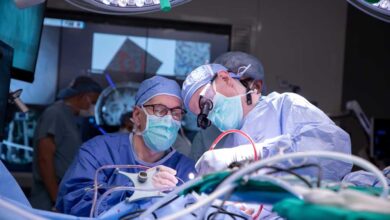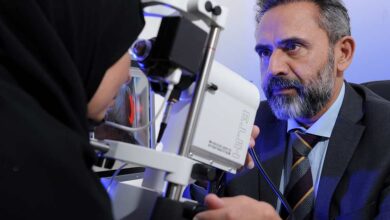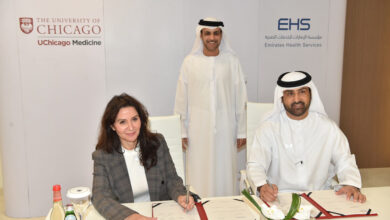Dr. Aicha Hind Rifai
Assistant Professor of Clinical Psychiatry at Weill Cornell Medicine-Qatar (WCM-Q)
“The Certificate in Health Humanities is open to all healthcare professionals, including physicians, nurses, pharmacists and dentists, but also to allied health professionals and medical students.”

Dr. Aicha Hind Rifai is Assistant Professor of Clinical Psychiatry at Weill Cornell Medicine-Qatar (WCM-Q). A firm believer in the healing potential of the arts, Dr. Rifai is a researcher and practitioner in the health humanities field. Dr. Rifai is the co-director of a two-part certificate course offered by the Division of Continuing Professional Development at WCM-Q which aims to equip professionals working in the health sector with key skills and knowledge relating to therapeutic uses of the medical humanities in clinical settings. The course, entitled Certificate in Health Humanities: Clinical Applications, comprises three modules that revolve around the application of Narrative Processing Therapy, Life Review and Visual Art Therapy for patients with specific clinical conditions.
Dr. Rifai is a diplomate of the American Board of Psychiatry and Neurology in Psychiatry and in Geriatric Psychiatry. She is also a diplomate of the American Board of Internal Medicine. Prior to joining Weill Cornell Medicine Qatar, Dr. Rifai served as a clinician teacher in a variety of academic and clinical settings. Dr. Rifai received her M.D. from the University of Aleppo Faculty of Medicine in the Syrian Arab Republic.
Can you please explain a little about the Certificate in Health Humanities and its applications?
The certificate program is co-directed by myself and my WCM-Q colleague Dr. Krystyna Golkowska, PhD and we have designed it to give healthcare practitioners in many fields the opportunity to explore established therapeutic uses of the medical humanities in the clinical setting. The certificate is delivered in two parts, the first of which focuses on the benefits of narrative disciplines and creative art approaches. In the second part, we focus on three therapeutic approaches that have a strong basis in research regarding their effectiveness, these being Narrative Processing Therapy (NPT), Life Review, and Visual Art Therapy (VAT). The certificate also explores the methodology of these interventions and their effectiveness in certain conditions such as Post-Traumatic Stress Disorder (PTSD), end-of-life and palliative care and other clinical settings. These are circumstances in which the health humanities can be particularly beneficial for patients, their loved ones and their caregivers.
Can you tell us a little more about these three approaches?
Narrative Processing Therapy (NPT) is currently one of the leading evidence-based psychotherapies used in the treatment of Post-Traumatic Stress Disorder (PTSD) resulting from a variety of experiences (rape, abuse, civilian and military personnel in war zones, survivors of natural disasters, and so on). NPT utilizes narrative techniques and techniques of storytelling and remembering, and is administered individually or in groups. Through narration, newer studies have documented the efficacy of short courses of this therapy, as well as benefits lasting up to 12 months or more. The research shows that most people who complete a short course of NPT show a noticeable improvement in PTSD symptoms.
Life Review was developed by a German-American developmental psychologist and psychoanalyst named Erik Erikson. Studies in older adults on reminiscence and Life Review and narrative psychology have shown that it is not the past events themselves but their personal meaning that is pertinent in regulating identity development, well-being, and mental health across the lifespan. In hindsight, people may look back upon their lives and discover their past as a source of insight and inspiration even when facing adversity. Studies have shown the efficacy of Life Review in depression and in palliative care and in grief situations in the elderly. Although the intervention was initially used in aging populations, its application in young adults facing a critical illness or following psychological trauma has shown significant efficacy.
Visual Art Therapy (VAT) has been shown to be useful for patients of all ages in many healthcare settings, but this certificate focuses mainly on its use in the areas of end-of-life and palliative care, where it is beneficial not only for patients but also for caregivers. As terminal illness invokes physical, psychological, and spiritual manifestations in patients, research has shown that art can help decrease feelings of pain, and also decrease the use of painkillers. This is beneficial because painkillers can dull the emotions and at times increase cognitive impairment, thus interfering with the ability of patients to interact with their families and complete important emotional tasks that bring positive feelings of closure for patients and their loved ones.
Art can also calm anxiety about death and promote hope and the integration of the human domains of functioning in patients nearing the end of their lives. Similarly, teams engaged in the care of the terminally ill have found support and equilibrium in VAT to help them face grave situations with patients and their families and prevent burnout. We believe this approach is effective because humans need meaning in their lives and one of the main functions of creative endeavors is to bring meaning into life and lived experiences.
At whom is the Certificate in Health Humanities aimed?
The certificate is open to all healthcare professionals, including physicians, nurses, pharmacists and dentists, but also to allied health professionals and medical students. We also find the certificate popular with medical residents. We feel it is important to note that using the humanities in healthcare should not be viewed as the exclusive preserve of psychiatrists or psychologists. The health humanities have been found to be beneficial for patients in almost all healthcare settings and useful for healthcare practitioners in almost all fields. Indeed, when the movement in the health humanities really began to gain momentum in the United States about 15 years ago it was promoted by and for all types of healthcare professionals. We do see a lot of interest from nurses who feel they want to add something more to their skills to allow them to go beyond the standard, traditional medical approach.
How is the certificate course delivered?
The course is based upon three online modules (one per week) which discuss the three therapeutic approaches in turn, guided by myself and Dr. Golkowska, each of which takes around five hours to complete. We introduce each module with a synchronous meeting, each of which begins with a presentation about the therapeutic approach at hand; this is then followed by a group discussion and a Q&A session. Other activities include reflections on assigned multimodal texts and three written assignments. Each certificate course spans three weeks in total.
How can healthcare professionals integrate the medical humanities into their normal practice?
Because the humanities are by their nature based on human behavior, we find that many healthcare professionals are naturally doing some of the things that the three approaches recommend. That’s why there is so much interest in these skills because they feel, to many health professionals, like important but somewhat overlooked part of healthcare. It is something that a lot of people who go into the health professions are interested in in the first place—being empathic, being interested in people, asking questions, wanting to know more about the person to whom they are providing care.
So, the skills that we are giving them here are complementary to something that they are already doing, it validates their belief that this is important and effective, and gives them motivation and skills to do it in a certain way that is more productive and beneficial.
What competency gap does the certificate program seek to address?
There are many studies showing clear evidence of the benefits of all three of the interventions we explore in this certificate program, but the biological model of medicine that has become more dominant in the last 20 to 30 years with the discovery of a lot of very effective medications has made some people forget the tradition of medicine that we are asking to return to. Because the really great physicians from history who we look up to as role models understood the need to treat both the body and the soul, because you cannot separate them. If you look at the biographies of people like Ostler (Canadian physician and educator William Ostler, 1849-1919; called the ‘father of modern medicine’) or Charcot (French neurologist and educator Jean-Martin Charcot, 1825-1893; known as the ‘founder of modern neurology’) you see they had a great understanding of and interest in both the soul and the body.
The best practitioners have always been the ones who are close to their patients, who know their patients really well, to whom patients come with personal stories and dilemmas, not just because they have one symptom and they need a pill. In the last 15 or 20 years, this movement of narrative medicine, narrative therapies, and humanities in medicine has identified this gap and developed research and educational programs to address it. Indeed, many medical school programs now integrate these approaches into their curricula; this certificate program aims to address this gap but with a broader focus that allows a wider range of health professionals to gain skills in this field. We feel this approach will allow more patients, their loved ones and more health professionals to benefit from these highly effective narrative-based interventions which we feel make very important contributions to overall health and well-being.
















